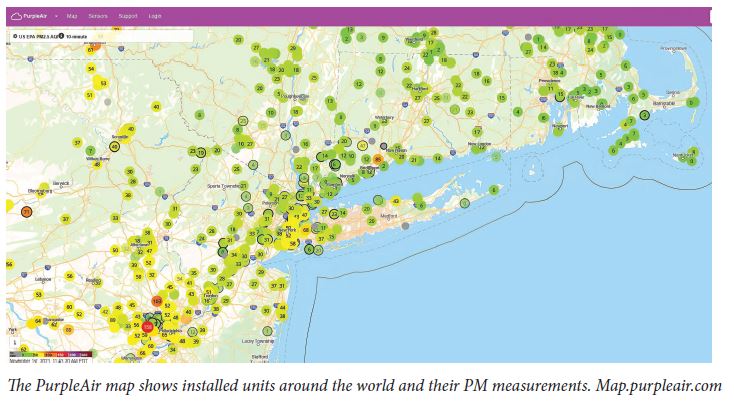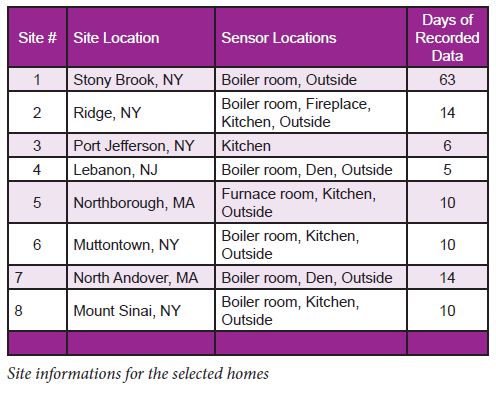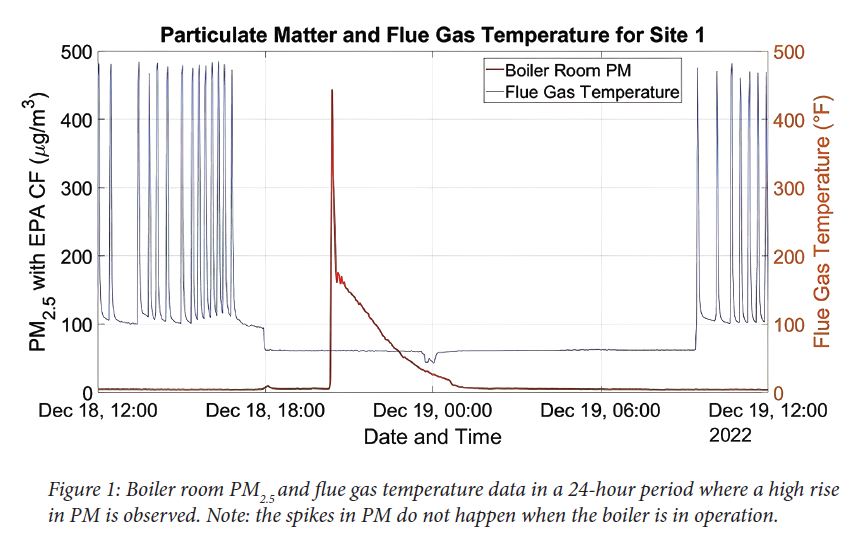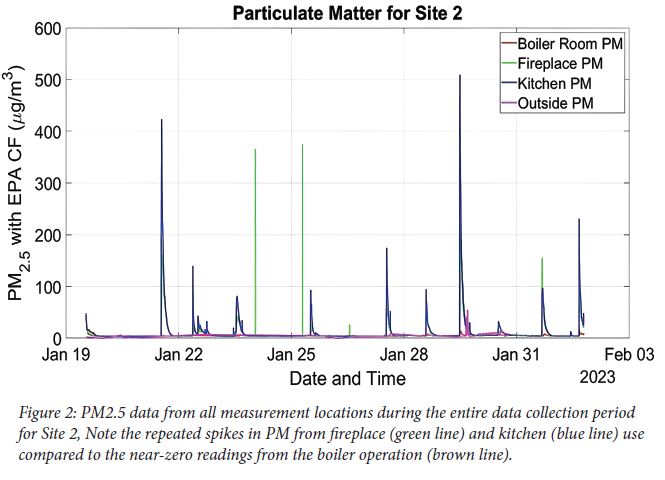Indoor air quality has become a newsworthy topic as certain pollutions have been identified as health hazards by, among others, the U.S. Environmental Protection Agency (EPA). It has been suggested that combustion powered home heating appliances are some of the sources of these indoor pollutants. As combustion powered heaters make up almost 75% of all heating appliances, NORA deemed an investigation was in order.
Of particular interest is particulate matter (PM), which is known to have both human health and negative environmental impact. NORA, at its Liquid Heating Fuels Research Center in Plainview, NY, took a deep look into PM in home living spaces to determine whether liquid fuel combustion devices negatively impacted indoor air quality.

Fortunately, a low-cost and effective method of measuring PM has recently entered the marketplace. Named PurpleAir sensors, these devices measure PM, PM2.5 and PM10 (the subscripts denote the particle sizes in micrometers [µm]) in micrograms per cubic meter (µg/m3), which indicates the actual amount of particulates found in the air. Using dual laser-based particle counters, they can measure particles larger than 0.3 microns with counting efficiency, reported by the manufacturer to be 50% at 0.3 microns and 98% at > 0.5 microns.
Test Sites
The PurpleAir units can be installed to perform stand-alone, storing its readings offline, or connected to the internet to display the PM2.5 concentrations at its location on a worldwide map of an increasingly expanding network. For the NORA study, only offline measurements were used in houses with primarily a liquid-fuel-fired heating appliance. Eight homes—five in NY, two in MA and one in NJ—were chosen for this study. Seven of the eight were selected because they contained a liquid-fuel-fired heating system. The other was chosen to record data in the den area (kitchen and living room with a fireplace) during a time when the homeowner planned to cook and light a fire in a wood stove. A set of PurpleAir sensors was provided for each home. Typically, at least one indoor and one outdoor sensor was installed in each site. Four of the sites were fitted with a flue gas measurement sensor to indicate when the heating system was running.

Liquid fuel-fired boiler and furnace installations typically include barometric dampers, which are draft-operated “doors” that open to allow room air into the flue pipe to prevent high draft levels. High draft levels can change burner air fuel ratio and, in an extreme case, can destabilize a flame. Modern burners for liquid fuels have higher static pressure fans and are less influenced by these draft changes, but barometric dampers are commonly found in many installations. Barometric dampers may be a potential source of indoor air pollution as flue gas could spill into the room during startups. While this does not usually happen with modern equipment, the Purple Air sensors were placed as close as possible to the site barometric dampers to record possible spillage.
Correlation of PM Spikes
For some of the sites, the boiler room was found to have periodic spikes in PM2.5, but when paired with the “on” measurements of the flue gas sensor, it was shown that the heating system operation did not correlate to these spikes. One example is shown in Figure1, where you can see a plot of the PM2.5 concentrations (left y-axis) and the flue gas temperature (right y-axis) and the time (x-axis) over 24 hours. During this period, there was a major peak (close to 450 µg/m3 in PM2.5) concentration observed in the boiler room where the PurpleAir sensor was located approximately six feet from the boiler flue pipe. Upon consultation with the homeowner, it was found that he had performed soldering of metal pipes without ventilation in the boiler room. The flue gas temperature readings show the boiler was not operating nor did it operate during a period of approximately four hours before and approximately 12 hours after the soldering took place.

It was also found in the data from other sites that cooking and fireplace use had a major impact in indoor PM2.5 concentrations. Additionally, outdoor grilling also caused rises in indoor PM2.5 concentrations when doors and windows were left open to allow particulate matter to enter the home.
In the example illustrated in Figure 2, indoor cooking and fireplace activity (green and blue lines) caused major spikes in PM2.5 concentrations, while the sensor in the boiler room remained at near zero. This look into combustion from liquid-fuel-fired heating systems was found to have no significant impact on indoor air quality as was indicated by the PurpleAir recording of particulate concentration. Other indoor combustion activities, and use of wood heating in the area around the home sites, were found to produce elevated levels of indoor PM2.5 concentrations within the specific homes being monitored.

These results are important as they indicate combustion in properly operating liquid heating appliances does not impact indoor air quality. To improve the health and safety of home dwellers, other household activities, such as cooking, fireplaces and outdoor grilling should be carefully examined. ICM

ICM: Michael, you have been in the industry for a very long time in varying roles—a member of a family-owned liquid heating fuel retailer, a consultant for retailers venturing into renewable fuels and an executive for a biofuel producer. What attracted you to the NORA position?
Devine: When I found out that John Huber, one of NORA’s founders and its only President to date, was retiring, my initial reaction was, “Wow, that’s a big loss.” Of course, when my name came up as a candidate, I was very flattered, but I was in the midst of building something commercially with World Energy.
When I saw that the liquid heating industry was moving to decarbonize, that this was going to be the vision, it attracted me. I asked my wife what she thought, and her response was, “They need you.” I didn’t expect that and it moved me a little bit. I put my name into the hat and went through the phenomenal process that the executive committee came up with, which went on for several months. Each time we went through another phase, my interest in the job grew. I felt very fortunate to be offered the job.
ICM: You joined NORA as its President a little over a year ago. What did you find once you got there?
Devine: First, understanding the totality of what NORA does was very impressive. I knew there were some educational aspects, I knew they ran some programs, but going through the interview process showed me all the different things that NORA touches in a significant way—technical education, research and development projects, the energy efficiency program and work with equipment manufacturers. The kind of impact that NORA can have and does have is eye-opening.
ICM: Now that you have had a year, can you offer your 30,000-foot view of NORA’s’ position in the industry?
Devine: We are fortunate not to be involved in legislative activity, which is prohibited by NORA’s Federal statute. This allows us to focus on the industry as a whole from an equipment standpoint, from a fuel standpoint, from an educational standpoint and not have any type of political eye as we approach these programs. With our strong employees, as well as our strong contractor contributors, we need to be “Thought Leaders” for the Industry. We need to always look ahead to where the Industry is likely to go.
ICM: I know it’s been a very busy year. What comes to mind as some of the bigger things that NORA has done in the past year?
Devine: You’re right, we have been busy. There were many initiatives coming in before I came to NORA, including the testing of higher biofuel blends. We completed much of the B50 testing and have now moved to B100 testing. This year, we are also testing renewable diesel and renewable diesel blends. As we need to accelerate our transition into higher blends of low carbon fuels, NORA is doing the work to identify the challenges.
However, things then get thrown at us that we weren’t planning on. For instance, I got a call from Chris Herb, Connecticut Energy Marketers Association, last Summer asking if NORA was aware of what was going on regarding building codes and the International Code Council (ICC). We weren’t. However, we got involved with the rulemaking process with Bob O’Brien taking the wheel.
I believe that our involvement has very much helped maintain liquid heating’s place in the codes and I think the code enforcement community is recognizing the voluntary decarbonization strategies our industry is following. Fortunately, because of our size and the nimbleness and quality of our staff, we do have the ability to move quickly.
As I was coming in, our technical manual was in the process of some terrific updates with revised content, enhanced user-friendliness for the technician and the addition of an audio accompaniment. We also introduced the online Technical Resource Center, compiling much of the material from our education series, including YouTube videos, documents and bulletins, some generated by NORA and some from other vetted third parties, including equipment manufacturers. If a service tech finds themselves at 10:00 p.m. in a basement with questions, he or she can reference the Technical Resource Center and we hope they will find what they need.
To focus on the importance of education, we are hosting a Train the Trainer series workshop in June 2023. We’re bringing in a professional educator, with expertise in teaching methodology and practices, to come in and work with some of our technical trainers to help them improve as teachers. It’s a very extensive three-day event and I’m looking forward to sitting in, myself.
At its conclusion, the graduates will be “NORA Accredited Trainers,” which is a new designation to show that they have both technical expertise and teacher training. We hope NORA can deploy these folks to areas that do not have access to our curricula.
We began discussions on the Net Zero Carbon Home just about a year ago. Now, we have a working model with a home on Long Island, NY, using 100% biodiesel partnered with solar panels. It is showing a net zero carbon output. We’re now having meetings in various States to develop additional model homes. That’s something that we’re very proud of.

In 2022, the Inflation Reduction Act was passed and with that a $600 consumer tax credit for the installation of a liquid fuel-fired heating system rated to use biofuel blends. It was the National Energy & Fuels Institute’s (NEFI) lobbying efforts, with important input from the Oilheat Manufacturers Association (OMA), that marshaled that through. NORA quickly did all it could to inform the industry of this opportunity with press releases and in-person events. NORA also saw the opportunity to add the Building Performance Institute’s (BPI) certification for home energy audits as part of our education curriculum.
Bob O’Brien is currently taking the tests, and he’ll be qualified to teach the BPI so that our team, our folks, our technicians will be able to get into homes and conduct home energy audits. These audits could provide homeowners with considerable tax credits, worth thousands of dollars, for equipment upgrades, as well as upgrades to the building envelope. The liquid fuel marketers and service companies will have the opportunity to become home energy consultants.
We want to be able to communicate all the technical and educational work that we’re doing in a user-friendly way and, with that, NORA has created a podcast series called In the Loop with NORA. It began with Brian Clark, Kentucky Petroleum Marketers Association, relaying to me how they use podcasts to communicate to their members and the community at large. We agreed to have Brian and his team produce our series.
We have two episodes completed and they can be found on NORA’s website, the podcast website and through numerous podcast services, such as Spotify, iHeart, Apple Podcasts and Google. Brian is doing a brilliant job with discussing these subject matters with the podcast guests in a conversational way so that it’s easier to digest and understand, and hopefully we can provide more value in communicating the programs to the industry.
We’ve heard the call from some of our constituency that particulate matter from heating appliances is something that some folks are very concerned about. In response, NORA’s Technical Director, Dr. Thomas Butcher, and his team at our Liquid Fuels Research Center in Plainview, NY, have employed portable, internet-connected sensors, known as Purple Air Technology. This allows us to measure particulate matter inside the home. We’re setting up tests near heating appliances, by the fireplace or wood stove (if there is one) and in the kitchen.
What preliminary findings show is the highest levels of particulate matter are coming from cooking. We can collect this data so that decisions are made based on facts and not on assumptions.
Another highlight from the past year was our OEM conference. With assistance from OMA, we brought liquid fuel-fired heating equipment manufacturers together to talk about how the industry can move to the highest blends of biofuels. It seemed we had a consensus and moved the needle forward towards decarbonization.
This dovetails with our partnering with Clean Fuels America on a higher blends infrastructure workshops. We want to look at the challenges and the opportunities in higher blends. We want to look at it from production of renewable fuels all the way through the logistical supply chain, whether it be pipeline or vessel or rail, through the transportation logistics, storing it and getting it to the consumer’s tank. We want to see where there are weaknesses in our supply chain so that we can collaborate and address them.
ICM: I see that NORA has added a new member to its R&D team.
Devine: One of our esteemed consultants, Richard Sweetzer, is retiring this year. How do you fill a void left by somebody like Richard? You don’t, is the short answer. Part of my responsibility is identifying new talent in and around our industry. Dr. Jenny Frank came on our radar screen when she was named a Next Generation Scientist for Biodiesel by the National Biodiesel Board (now Clean Fuels Alliance). Since then, she has earned a Ph.D. from the State University of New York College of Environmental Science & Forestry. Her expertise is in analyzing technical and economic pathways for renewable energy.
Dr. Frank is currently a professor at SUNY Morrisville and we are very pleased that she has joined the NORA team as a Research Associate. Dr. Frank and Dr. Butcher are going to put their heads together to see where we can continue to expand our activities at NORA, bring others in and look at other research partners so that we can scale up our projects. Identifying young talent is essential to us moving forward.
ICM: What challenges do you see for the industry over the next five or 10 years and how do you see NORA addressing them?
Devine: Clearly, we recognize the movement afoot to decarbonize all things. The programs that we’re conducting right now, with higher blends of low carbon fuels, are a big piece of this. I think we also have a role to play in the environmental science of our industry and that is why we chose to bring in Dr. Frank.
We’re collaborating right now with Eco Engineers on the Greenhouse Gases (GHG) multivariable calculator that Richard Sweetzer created for us. We can look at the environmental data so that we can provide the States and other stakeholders with solid, unimpeachable science that they can use to convey the message that our industry is not part of the problem, but part of the solution.
One of the real values that renewable liquid heating has is our ability to decarbonize. If it’s not the most cost-effective way, it’s certainly one of the most cost-effective ways to do that. From NORA’s perspective, this has become our overriding thesis.
ICM: NORA has as strong history of collaboration with other stakeholders in the industry. This now seems to be more important than ever.
Devine: I think NORA’s responsibility for leadership in the industry is to build collaborations. NORA has long-standing relationships with the NORA Alliance retailers, the various State Associations and, of course, our friends at Clean Fuels America.
It is imperative to work within the commercial markets as well. From speaking with the wholesale community, we found ourselves getting involved when there were concerns around fuel supply shortages last fall. I had the opportunity speak to leadership at some of the major wholesale suppliers to try to understand what those challenges were. Having active collaboration with the renewable fuels community, both in the biodiesel and the renewable diesel production side of it, is helpful for us to receive product to test and to also collaborate with them on what our industry is trying to do.
Collaboration with OMA and the liquid fuel equipment manufacturers is also critical. Dr. Butcher and I have spent personal time with both Carlin Combustion and R.W. Beckett Corp. addressing the industry’s needs, as well as the opportunities presented by decarbonization.
Dr. Butcher and I just returned from Europe where we attended the International Trade Fair for Sanitation, Heating & Air (ISH) Expo and visited many manufacturers, as well as NORA’s European counterpart, Eurofuel, to share like experiences and the challenges faced on both sides of the Atlantic. Many are the same and, in some cases, Europe is ahead of us and in other cases, the U.S. is ahead of them.
If NORA is going to continue to be successful, I think it’s largely going to be due to our ability to collaborate with all these stakeholders, listen intently to what’s going on, and then build strategic programs around what can be the most effective for the liquid heating industry. ICM

As the best winter in years draws to a close, I am particularly happy that the National Oilheat Research Alliance (NORA) will once again be a full partner with the oilheating industry and its customers. As you know, the efforts of the industry over the past five years have been rewarded with an extension of the program until 2019. So, once again, we need to work hard to ensure that we are contributing to the retail companies that fund the program and oilheat consumers.
Like any company, we need to increase our investments in technology. The only way to maintain our customers is to continuously improve the product we sell, its reliability and the features that it provides. Additionally, we must improve its efficiency while at the same time making it cleaner. As the industry converts to a lower-sulfur product, scale will essentially disappear, as will the sulfuric acid in emissions. This will enable us to develop smaller units with less expensive materials. NORA will be working on many projects to help our manufacturers prepare for this new fuel.
We also are working to improve our educational offering. We are working to develop a stronger educational track with our service technicians and Oil and Energy Service Professionals (OESP) that will help guide them into the next level of their careers. We have developed an advanced curriculum pertaining to the following subjects: energy efficiency, steam, hydronics, venting, air distribution and electronic controls. This will help ensure that our technicians provide value to their customers.
Our volunteer leadership is now developing plans for the organization’s programs in the coming years. Your thoughts, comments and ideas are all welcome and I look forward to working with you